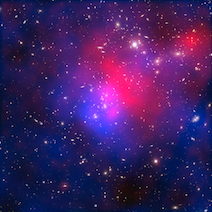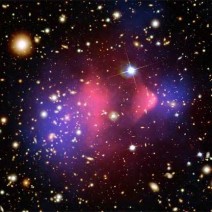Astronomers have studied one of the most interesting galaxy clusters, Pandora’s cluster. Probably formed by complex and violent collisions, the unusual cluster has many features never seen before.
At least four galaxy clusters had to collide to form Abell 2744, or Pandora’s cluster. Its nickname comes from the multiple strange phenomena that were unleashed during the enormous collision. Thanks to combined data from the NASA/ESA Hubble Space Telescope, ESO’s Very Large Telescope (VLT), the Japanese Subaru telescope and NASA’s Chandra X-Ray Observatory, scientists were able to recount 350 million years of history.
Although the galaxies in the cluster are clearly visible, they account for only about 5% of its mass. Gas accounts for another 20% and only shines in X-rays, while the rest is invisible dark matter. Dark matter’s presence is betrayed by a phenomenon known as gravitational lensing: light rays are bent by dark matter’s gravitational field, producing distortions in the images from Hubble and VLT. This allows astronomers to map the distribution of dark matter in the cluster.

Pandora’s cluster seems to have formed from four different clusters that collided over a period of 350 million years, creating many curious features. The hot gas, observable in X-rays, dark matter and the visible galaxies all lie apart from each other. In the center of the cluster, a “bullet” is visible: during a collision, the clusters’ gas collided and created a shock wave. Dark matter wasn’t affected by the collision. Somewhere else in the cluster, gas has disappeared, leaving only dark matter and galaxies.
The outer parts of the cluster contain only dark matter, maybe telling astronomers how it behaves and how all the ingredients making up our Universe interact with each other.
Clusters of galaxies are the biggest structures in the cosmos, and studying their formation and evolution is invaluable, and will help better understand our Universe.
Video credit: ESA/Hubble, ESO

